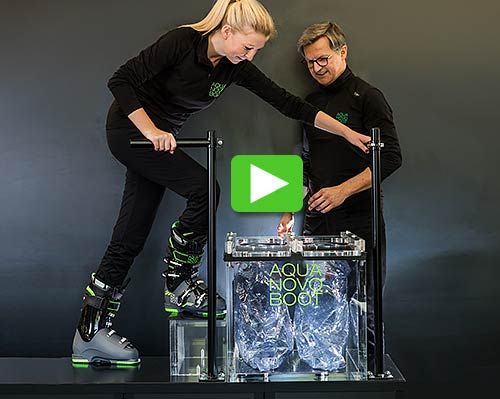Bootfitting
Custom made ski boots are more
than a custom fit
We are often told by our customers that they have had their former ski boots made by a bootfitter, but that the ski boot still did not fit or was even painful. A number of bootfitters claim that they offer a fitting and that they can make a customized ski boot. But this is simply not the case.
“Bootfitting“ means simply ”optimising“ an already existing standard “basic form“ of boot. Typical bootfitting is not made-to-measure, it is more making adjustments to pre-prepared ski boots. The comfort, stablity, etc. are not nearly the same.
This is what a bootfitter does with a ski boot:
There are four common methods. In one of them, the makers of ski boots have already integrated the fittting into their boots, for example by an adjustable liner or by an upper boot that can be shaped by the application of heat. There are also traditional pre- and post-adjustments of ski boots by means of tools. And even the simple sale of a pre-adjusted insole is sometimes regarded as bootfitting!
The meaning of “bootfitting“ is not easy to state clearly. It is as if one were to try to nail a pudding to the wall.
This is the difference of a customized ski boot

What we can state with 100 per cent certainty is that bootfitting has nothing to do with ski boots made to measure. Only a ski boot consisting of the following elements can be considered a customized ski boot:
- Ski boot shape (without liner)
- Custom-filled liner
- A ski boot insole (not pre-formed, simply a flat blank) to give an individual footbed
If you have these three elements, then you are having a custom made ski boot for you, and this has nothing to do with bootfitting.

Find your store …
… near you or on your trip to a skiing destination. You will find locations of AquaNovoBoot specialist suppliers in Germany, Austria or Switzerland.
What the AquaNovoBoot offers


Pros of bootfitting:
- There are, quite obviously, skiers who have no problems, or no serious problems, with their boots.
- For such people, a ski boot which can perhaps be improved by the bootfitter with an insole, is a good thing.
- The skier’s ankle is slightly compressed; in this case the boot-leg can be expanded and more room created.
Cons of bootfitting:
- The limits of the bootfitting are narrowly drawn. It must be made clear at the outset that a ski boot can be precisely expanded – but only up to 5 millimeters.
- It is impossible to make the ski boot narrower, so as to obtain better holding or a flatter contact, it is not possible to fill up spaces or to reduce loose areas.
- As a result the basic form of the ski boot can be improved only partially; otherwise further problems arise. To make this clear, here are some examples:
- 1. In the case of fallen arches (so-called „flat feet“) it is mostly the inner ankle, which is painful because of the faulty position. As a result of widening on the inside, the ski boot becomes too wide on the outer side. The customer slips and there is no holding.
- 2. In many cases bootfitters expand the forefoot area since this is too narrow for the customer. By this expansion the height of the shape sinks and presses painfully on the instep. The bootfitting itself now creates a new problem.
- 3. In the case of problems such as intoe, exostosis or excessively large ankles, five millimeters are often not enough to provide enough room.
The boot is too narrow in one place and too wide in another. Bootfitting is no help here!
- For the most common fitting problems there is no help to be had from bootfitting if the ski boot is too wide in one place and too narrow in another.
- 4. For customers with small, narrow feet or muscular calves bootfitting is useless in advance. This problem particularly affects women.
- 5. The same applies to men with narrow calves and muscular feet. This combination cannot be solved by bootfitting.
Well now, are you interested?
Then take advantage of the AquaNovoBoot, invented by the former National skier Albrecht Zeisler.
